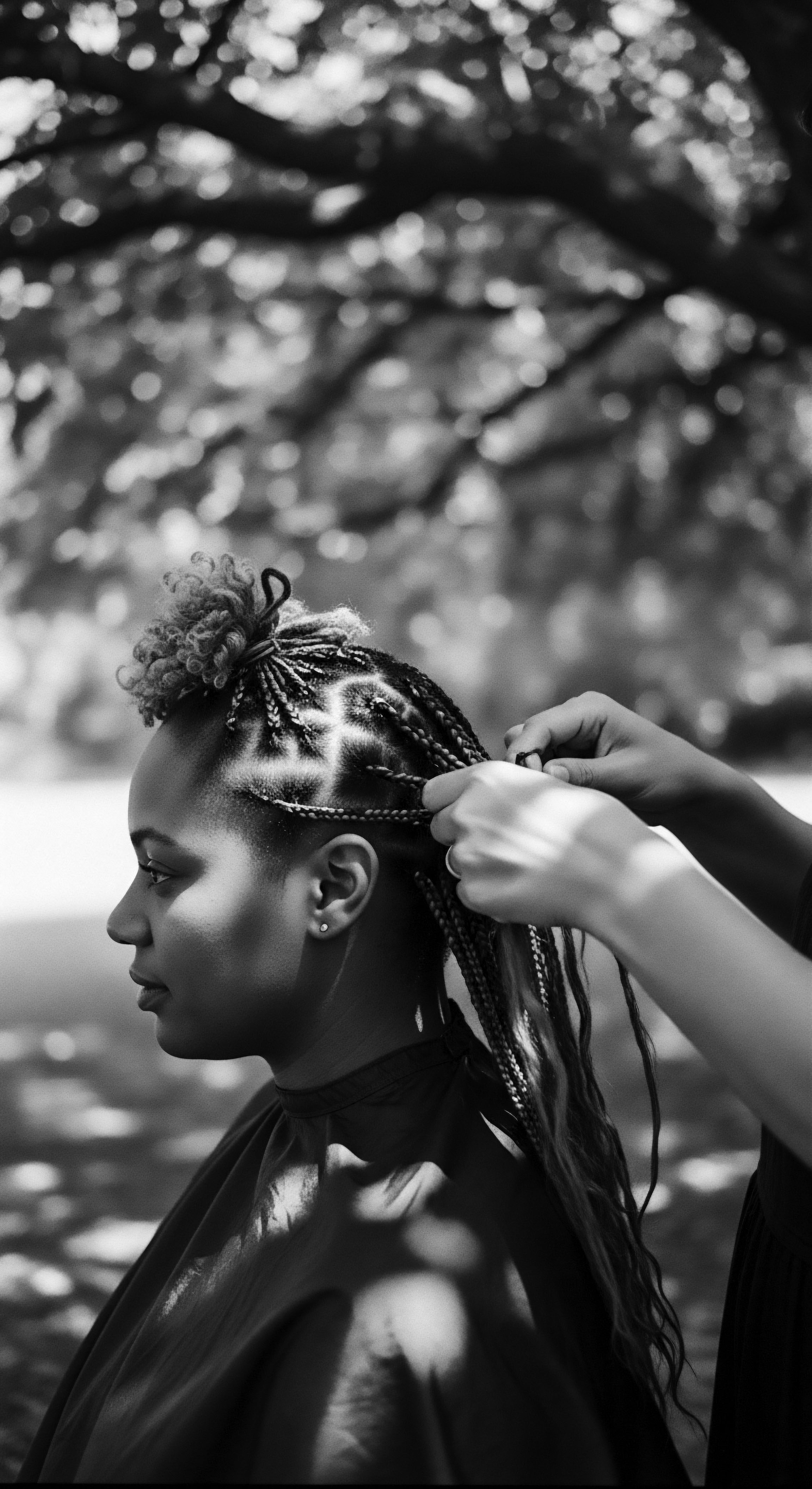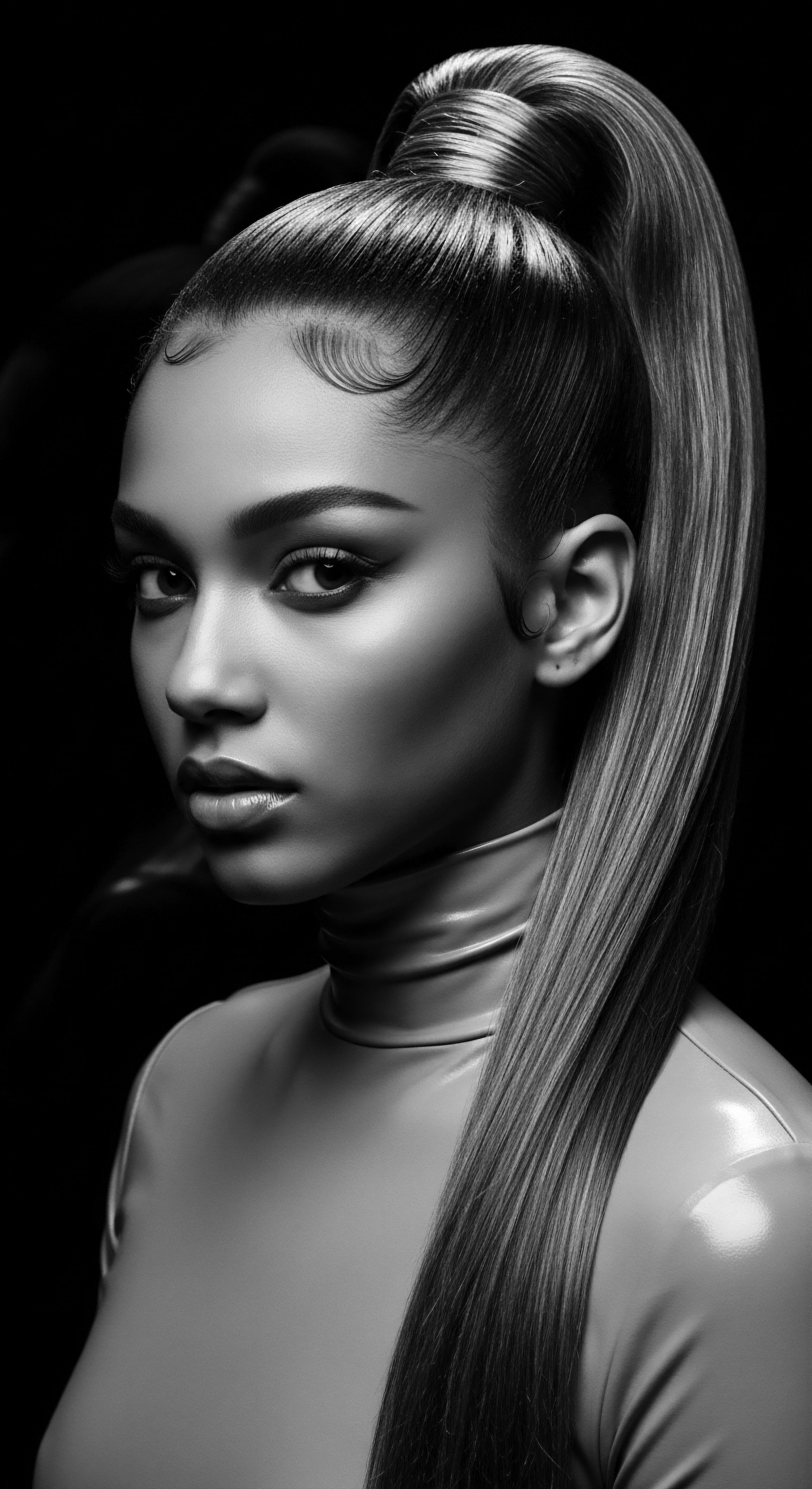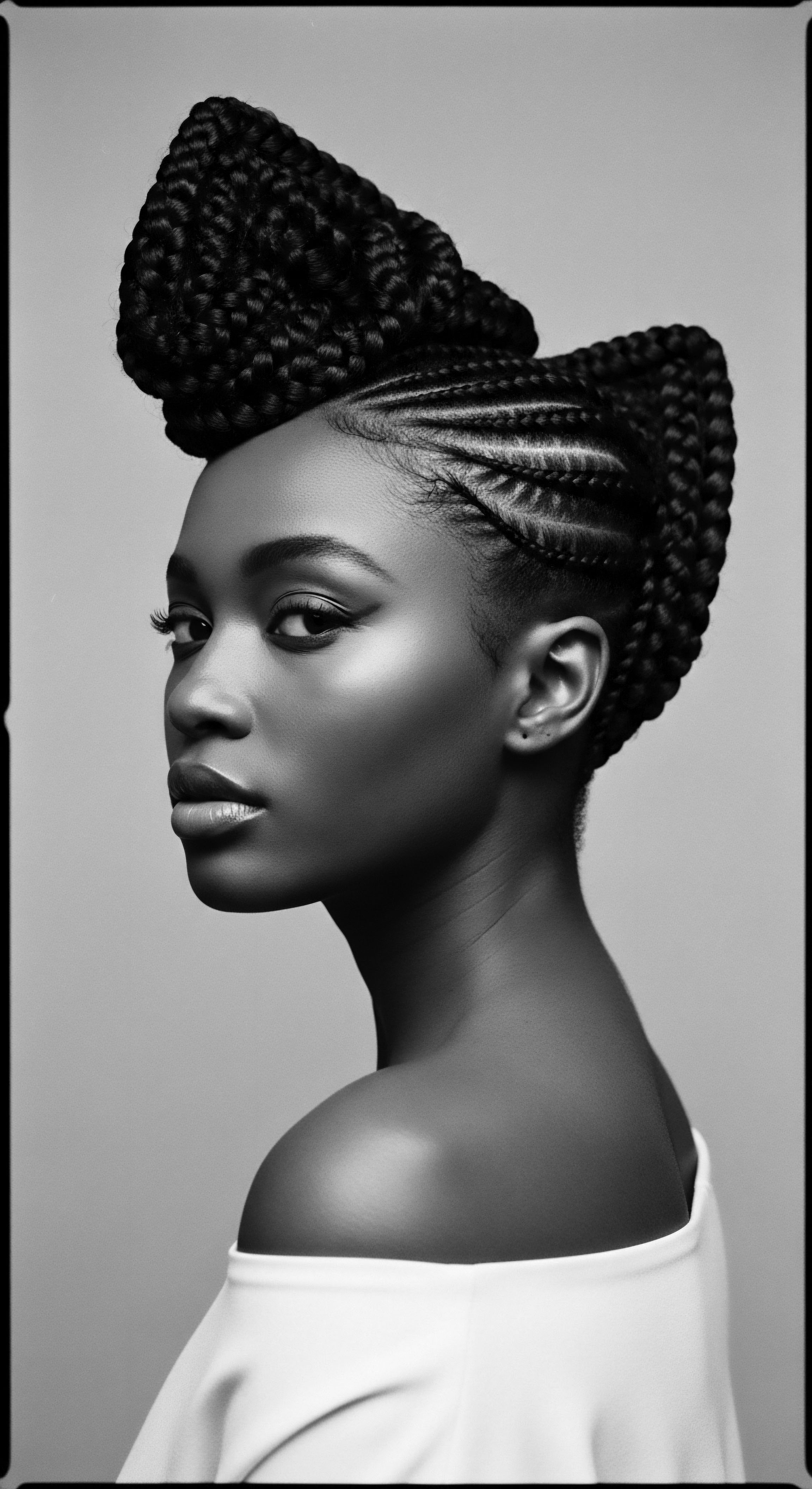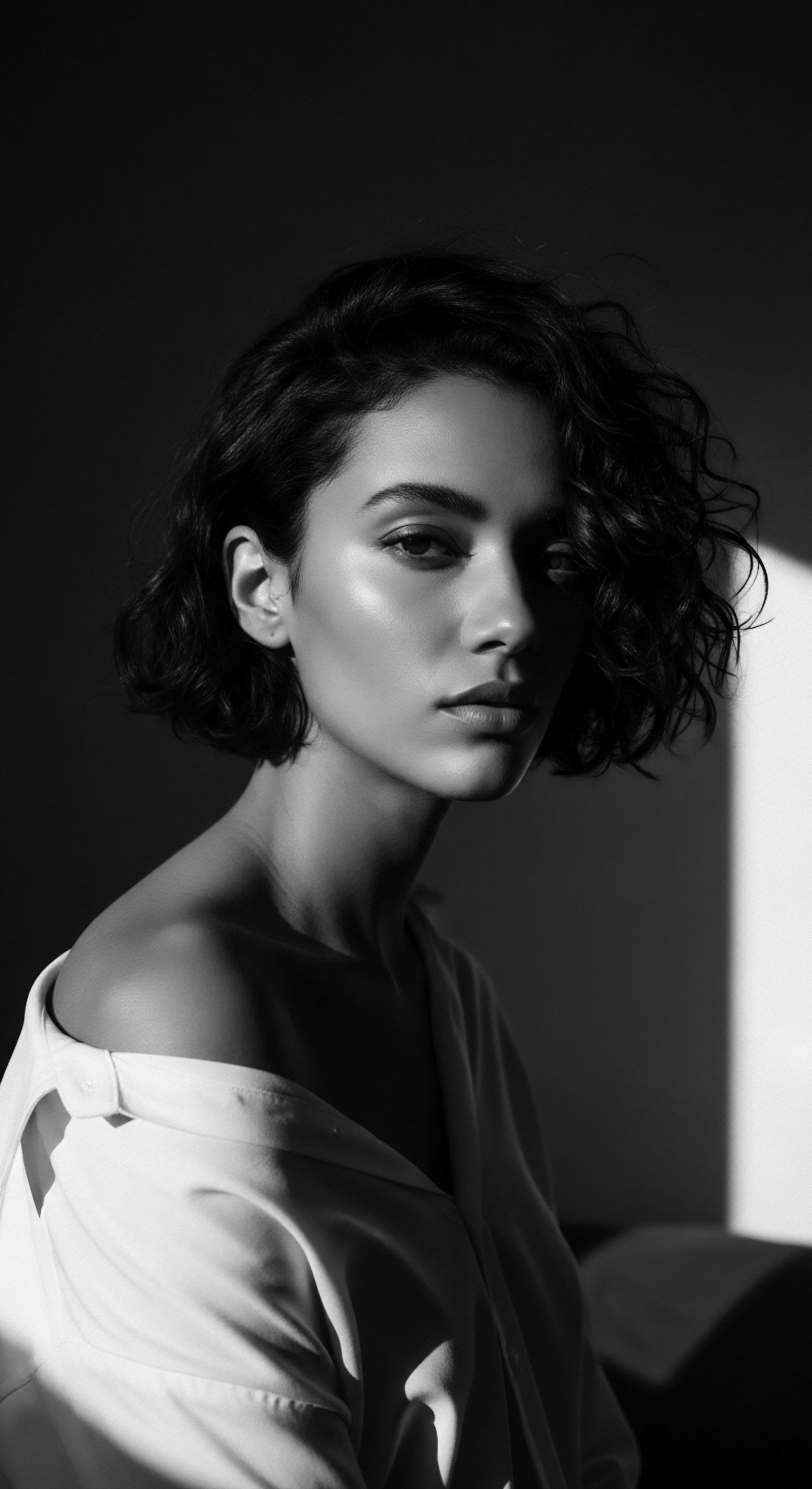
Roots
The very fiber of a strand, for those whose hair coils and bends, is not merely a biological structure. It is, profoundly, a living chronicle, a silent keeper of ancestral echoes. To truly grasp how historical African hair rituals shape protective styling today, one must first feel the resonance of this deeper truth. Our exploration begins at the very source, in the elemental understanding of textured hair, as perceived by ancient hands and validated by contemporary scientific inquiry.
Consider the hair itself. Each strand, unique in its spiraling journey from scalp to tip, carries a legacy of resilience. The distinct morphology of highly coiled hair—its elliptical cross-section, its irregular distribution of keratin proteins, its numerous points of torsion—renders it susceptible to breakage. This inherent fragility, however, is not a flaw; it is a characteristic that ancient peoples understood with an intimacy that surpasses modern textual definitions.
They observed the hair’s response to sun, to wind, to dry seasons, to moisture. Their understanding was not academic; it was a knowledge born of daily interaction, of necessity, and of an abiding respect for the body as a whole.
The intrinsic architecture of textured hair, observed and understood by ancient African communities, laid the groundwork for care practices that sought to protect its delicate nature.

Anatomical Insights and Ancient Interpretations
The hair’s anatomy, viewed through an ancestral lens, was often intertwined with spiritual and communal meaning. The scalp, the point of origin, was considered a sacred space, a conduit to the divine or to one’s lineage. From this sacred ground sprang hair that needed nurturing, protection from harsh elements, and intentional styling to maintain its integrity. Historical African societies, though without microscopes or chemical analysis, possessed an astute empirical knowledge.
They recognized that tightly curled hair, while striking in its sculptural possibilities, retained moisture differently and tangled more readily than straight hair. Their practices, therefore, were intuitively designed to counteract these predispositions.
- Sheathing ❉ Ancient communities often used clays, butters, and oils not just for adornment, but as a physical barrier. This early form of sheathing protected the hair shaft from environmental aggressors, a direct antecedent to modern leave-in conditioners and sealing oils.
- Coil Preservation ❉ Techniques such as braiding and twisting were not just aesthetic. They served to gather delicate coils, preventing excessive manipulation and mechanical stress, thereby preserving the hair’s length and strength.
- Moisture Retention ❉ The application of natural emollients—shea butter, palm oil, baobab oil—mimicked the scalp’s natural sebum, which often struggles to travel down highly coiled strands. This kept the hair pliable and less prone to brittleness.

Early Classification Systems and Hair’s Cultural Echoes
Across the diverse African continent, various groups developed their own ways of understanding and naming hair characteristics, often linked to age, status, or identity. While not formal scientific taxonomies, these classifications reflected a deep cultural insight into hair’s appearance and behavior. For instance, the Mursi of Ethiopia or the Himba of Namibia, through their distinctive preparations, recognized hair’s differing responses to styling and ingredients. These practical observations, honed over generations, informed the creation of hair care systems that were deeply intertwined with worldview and communal life.
The growth cycles of hair, too, held a certain ancestral wisdom. Although the precise anagen, catagen, and telogen phases were unknown, the cyclical shedding and regrowth of hair were surely observed. Practices like seasonal protective styles or hair cutting rituals might have aligned with these natural rhythms, perhaps intuitively supporting the hair’s life cycle by minimizing stress during periods of vulnerability. The nourishment for vibrant hair was drawn directly from the land, the same sources that sustained the body ❉ nutrient-rich foods, fresh water, and a lifestyle in harmony with the environment.
The very concept of hair protection thus originates from an ancient, intimate dialogue between people and their unique hair. It was a dialogue spoken in gestures, in shared knowledge, and in the careful application of earth’s bounty. The protective styling of today speaks this same language, albeit with new inflections.

Ritual
The journey from understanding the hair’s intrinsic nature to developing purposeful care practices unfolds in the realm of ritual. In historical African societies, hair care was seldom a solitary or superficial act. It was a communal ceremony, a transfer of wisdom, a symbol of identity, and a profound act of self-preservation.
These rituals, steeped in millennia of observation and ingenuity, form the deep well from which today’s protective styling draws its sustained vitality. What appears now as a modern styling choice carries the weight of centuries of ancestral ingenuity.
Across the continent, from the intricate coiffures of the Mangbetu women in Central Africa, stretched and adorned with wicker frames (a protective elongation technique), to the distinctive dreadlocked styles of the Maasai warriors, hair served as a living canvas. It was a marker of age, marital status, social standing, tribal affiliation, and even spiritual conviction. The very act of preparing and styling hair was often a multi-day endeavor, a labor of communal artistry, performed by skilled elders or family members. These sessions provided opportunities for storytelling, for instruction, and for the reinforcing of social bonds.
Hair rituals in historical Africa were multifaceted expressions of identity, community, and deliberate care, embodying the essence of protective styling.

From Ancient Plaits to Modern Braids
The roots of contemporary protective styling, particularly braids and twists, can be traced directly to these ancient practices. In West Africa, for example, cornrows (originating from the term “cane rows” or “corn rows” due to their resemblance to agricultural rows) served as a vital form of protection for hair, especially during periods of intense labor in the sun or during migration. These patterns, sometimes incredibly complex, communicated social status, family lineage, or even religious devotion.
Each plait, meticulously formed, shielded the hair from environmental damage, reduced manipulation, and encouraged length retention. This precise methodology is echoed in the very purpose of today’s braided styles.
Consider the Himba people of Namibia, whose women apply a mixture of ochre, butterfat, and aromatic resin to their hair and skin. This practice, known as otjize, serves not only as a beauty aesthetic but also as a powerful protective agent against the harsh desert sun and dry winds. The resulting braided locks are a testament to how traditional rituals simultaneously offered aesthetic appeal and unparalleled protection, a direct parallel to how modern protective styles shield textured hair from environmental stressors. (Brooks, 2013, p.
78). This deliberate application of natural elements for hair integrity exemplifies a protective styling philosophy.
| Historical Technique/Ritual Otjize Application |
| Cultural Origin/Significance Himba (Namibia) ❉ Identity, beauty, environmental shielding. |
| Protective Mechanism Ochre and butterfat coat strands, guarding against sun and desiccation. |
| Contemporary Parallel Moisturizing creams, UV protectants, sealing oils applied to braids/twists. |
| Historical Technique/Ritual Intricate Cornrowing |
| Cultural Origin/Significance West Africa (e.g. Yoruba) ❉ Social status, tribal markers, practical hair management. |
| Protective Mechanism Hair is neatly sectioned and braided flat to the scalp, minimizing tangling and exposure. |
| Contemporary Parallel Modern cornrows, stitch braids, micro braids. |
| Historical Technique/Ritual Knotless Braiding |
| Cultural Origin/Significance Fulani (West Africa) ❉ Aesthetic, practical for nomadic life. |
| Protective Mechanism Hair is braided from the root without adding tension at the scalp, safeguarding follicles. |
| Contemporary Parallel Knotless braids, promoting scalp health and comfort. |
| Historical Technique/Ritual Mudding/Clay Treatments |
| Cultural Origin/Significance Various African cultures ❉ Cleansing, conditioning, styling aid. |
| Protective Mechanism Clays (e.g. Rhassoul) absorb impurities while depositing minerals; act as a gentle cleanser and protective mask. |
| Contemporary Parallel Clay washes, deep conditioning treatments, hair masks. |
| Historical Technique/Ritual These ancestral methods reveal an enduring wisdom, providing templates for contemporary protective hair care. |

Tools and The Tender Touch of Care
The tools of ancestral hair care were often crafted from natural materials – bone, wood, ivory. Combs, meticulously carved, were not merely detangling instruments; they were often heirlooms, imbued with spiritual significance, passed down through generations. Adornments, too, played a protective role. Cowrie shells, beads, and precious metals were not just decorative; they could help secure styles, weigh down hair to prevent tangling, or denote a completed protective style ready for specific social engagements.
The very act of styling involved a tenderness, a skilled hand that understood the hair’s limits and respected its integrity. This gentle approach to hair manipulation, minimizing stress on the scalp and strands, directly parallels the modern understanding of low-tension protective styling.
The transmission of these hair practices was deeply oral and practical. Younger generations learned by observing and participating, their hands guided by the experienced touch of elders. This living pedagogy ensured that the knowledge of specific braiding patterns, the properties of local botanicals, and the nuances of protective application were preserved and adapted through time.
The enduring presence of protective styles today – from box braids to twists to locs – is a testament to the effectiveness and cultural resonance of these handed-down methods. They have persisted not by chance, but by their inherent capacity to sustain and celebrate textured hair, while also guarding it from the rigors of existence.

Relay
The continuous flow of ancestral wisdom into modern protective styling stands as a powerful testament to the enduring ingenuity of textured hair heritage. This relay of knowledge, often unspoken yet deeply felt, transcends mere aesthetic preference; it represents a profound understanding of hair biology, environmental adaptation, and cultural preservation. The scientific tenets governing healthy hair growth, which are now articulated in trichology textbooks, find their historical antecedents in practices refined through generations of lived experience.
One might ask, how does contemporary scientific understanding confirm the efficacy of these age-old protective methods? The principles are strikingly similar. Protective styles, whether ancient African plaits or modern Marley twists, function by minimizing manipulation, reducing exposure to environmental stressors (like sun, wind, and friction), and retaining moisture.
Textured hair, with its unique structural properties – particularly its elliptical cross-section and numerous bends – is prone to dryness and breakage at these vulnerable points. By coiling strands together, tucking ends, and creating a cohesive unit, protective styles effectively shield the hair shaft, allowing for length retention and overall vitality.
The relay of protective hair knowledge from ancestral practices to modern techniques underscores a deep, continuous understanding of textured hair’s unique needs and resilience.

The Science Echoes Ancestral Wisdom
Modern research consistently points to mechanical stress as a primary cause of breakage in highly coiled hair. Frequent combing, brushing, and styling can weaken the hair cuticle, leading to split ends and fracture. Historically, practices like tightly braiding hair or forming dreadlocks (which naturally lock hair strands together) drastically reduced daily manipulation. This aligns perfectly with the scientific recommendation to minimize physical stress on textured hair to promote its health.
Similarly, the ancestral use of heavy, emollient plant butters and oils was an intuitive recognition of textured hair’s tendency toward dryness due to the slower distribution of natural scalp oils down the hair shaft. These historical applications effectively sealed moisture into the hair, a practice echoed today by the “LOC” (liquid, oil, cream) method in modern hair care regimens.
The role of hair as a cultural and political statement, particularly in the Black diaspora, cannot be overstated. During periods of enslavement, protective styles were often maintained not only for practical reasons of hygiene and hair health but as quiet acts of resistance and identity. They were a link to a stolen heritage, a visual language maintained in the face of forced assimilation. Later, during the Civil Rights and Black Power movements, natural hair, including protective styles, became a powerful symbol of self-acceptance and a rejection of Eurocentric beauty standards.
The cornrow, for example, once a functional everyday style, became a symbol of defiance and pride, demonstrating the unwavering connection to ancestral practices. (Byrd & Tharps, 2014, p. 112).

Hair as an Archive of Identity
The legacy of protective styling, therefore, extends beyond the physical benefits to the profound psychological and sociological impacts. For many Black and mixed-race individuals today, choosing to wear braids, twists, or locs is a conscious connection to their ancestral past. It is a way of honoring the resilience of those who came before, a celebration of distinct beauty, and an assertion of identity in a world that has often sought to diminish it. This conscious choice is a vibrant continuation of a tradition that has spanned continents and centuries.
The future of protective styling appears to be one of continued innovation, yet always rooted in this rich heritage. New materials and techniques emerge, offering lighter, more versatile options, but the fundamental principles remain constant ❉ protect the hair, reduce manipulation, retain moisture. The evolution of braiding hair, for instance, from natural fibers to synthetic extensions, has expanded possibilities, yet the underlying function – to protect and adorn – remains tied to the core practices. This ongoing dialogue between ancient wisdom and modern advancements ensures that textured hair, and the heritage it carries, will continue its powerful journey, unbound and ever-evolving.

Reflection
To sit with the story of textured hair is to truly understand the spirit of a strand. It is to feel the weight of history in each coil, to recognize resilience in every bend, and to appreciate the profound continuity of care that has been passed down through generations. Our exploration of how historical African hair rituals intertwine with today’s protective styling reveals a heritage that is not merely academic, but living, breathing, and ever-present.
The ancestral practices, born of necessity and wisdom, were never static. They adapted to new environments, new challenges, new expressions of identity. And so too does the protective styling of our time.
It carries the wisdom of those who understood hair as a sacred extension of self, a profound marker of communal belonging. When one wears braids, twists, or locs today, there is a quiet acknowledgement of hands that labored before, of spirits that endured, and of beauty that simply refused to be confined.
This is more than a styling choice; it is a conversation with the past, a celebration of the present, and a hopeful declaration for the future. The strand, in its very structure and in its intricate care, continues to echo the soul of a people, preserving a legacy of strength, creativity, and enduring cultural pride.

References
- Brooks, R. (2013). African American Hair ❉ A History of Style, Culture, and Beauty. Praeger.
- Byrd, A. D. & Tharps, L. D. (2014). Hair Story ❉ Untangling the Roots of Black Hair in America. St. Martin’s Press.
- Opoku, A. A. (1998). African Traditional Religion ❉ A Source Book. FEP International Private Ltd.
- Patel, J. (2011). The Science of Hair Care. CRC Press.
- Mercer, K. (1994). Welcome to the Jungle ❉ New Positions in Black Cultural Studies. Routledge.
- Bundles, A. (2001). On Her Own Ground ❉ The Life and Times of Madam C.J. Walker. Scribner.
- Cole, G. (2008). Cultural Traditions of the African Diaspora. Greenwood Press.
- Jackson, R. L. (2010). Hair in African Art and Culture. Museum for African Art.
- Tredici, E. (2007). The Himba of Namibia. Princeton Architectural Press.
